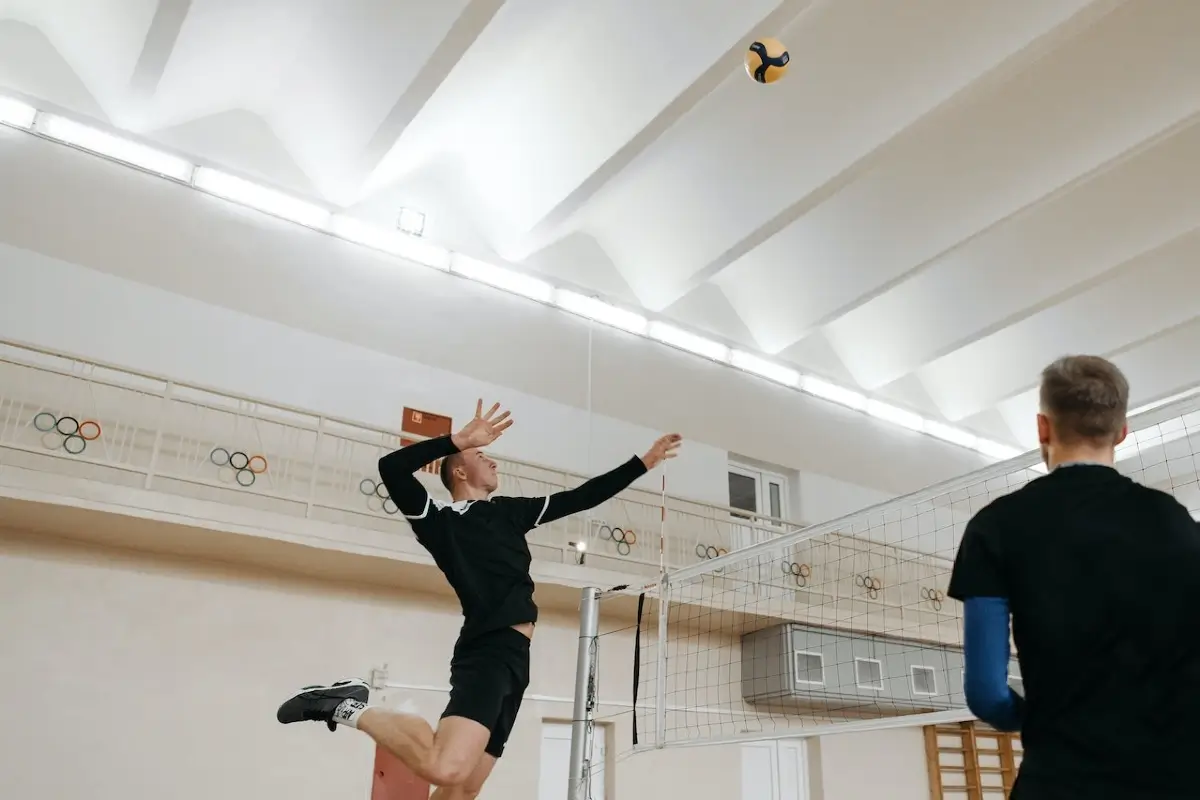Last Updated: November 21, 2023
Decoding the footwork and timing is vital for identifying certain lagging areas of your volleyball spike. Unless you identify the weak areas, you won’t be able to strike the ball with the perfect approach or technique.
A perfect attack is not just about hammering the volleyball to the other side of the net. You should also be able to land safely, which will enable you to play volleyball for many years and beyond without getting injured.
So, let’s decode the ins and outs of spiking footwork and timing to enhance your volleyball spiking skills.
Decoding Proper Foot Positioning Techniques

The better your foot positioning is, the easier it will be for you to get into the spike position. In general, there are four common foot positioning approaches used by volleyball spikers.
1. Four Step Volleyball Approach
The 4 step approach is typically used for jump or float serves. The first step would be short and quick in the direction of the target, followed by a larger forward second step (using the non-dominant foot). As you take the second step, you will prepare for the jump by swinging your arms.
You will take a larger third step with your dominant foot while swinging your arms in preparation for the jump. On the fourth step, you will explode off the ground with your dominant foot. You will swing both your arms upward to help you with the jump.
As you keep approaching the ball for the spike, your eyes will be glued to the ball. You can’t afford to lose focus even for a split second. As you jump, try to bring your non-dominant leg as close as possible to the dominant leg.
2. Three Step Volleyball Approach
Useful for fast attacks or tight passes, the 3 step approach is often used by players to reach the net quickly. In the 3 step volleyball approach, the order of the footsteps is the same as the 4 step approach. The only catch is that you will take one less step (the fourth step). In this approach, the third step is the jump itself.
3. Two Step Volleyball Approach
This approach is only used if there is a need to hit a quick set, such as the slide attack strategy. In this approach, you will quickly step forward with your non-dominant foot while swinging your arms backward for balance.
You will immediately follow it up with an explosive second step using your dominant foot while swinging your arms upward and forward. With a slight bend in the knees, you will leave the ground to jump vertically. You will then swing the dominant hand to strike the ball.
4. No Step Volleyball Approach
You will use a no step volleyball approach only when you have no time or space to react to an incoming ball. You will typically jump from a stationary position without taking any steps.
You will begin by maintaining a shoulder-width distance on your legs with a slight bent in the knees while keeping the weight of your body balanced on the balls of your feet. Then, both your feet will leave the ground simultaneously to reach the ball.
Pro Tip 1
You should always be in an athletic stance. It’s the most preferred stance for a volleyball movement because this position allows one to move quickly in all directions to make the appropriate move.
Pro Tip 2
Positioning your body behind the incoming ball is equally important. It puts your body in line with the ball and provides you with a good view of the incoming ball for efficient spiking.
Pro Tip 3
Inexperienced players often make the mistake of cutting off their teammates due to a lack of game awareness. This often causes misunderstandings and collisions. To avoid getting in other players’ way, it’s important to improve one’s peripheral vision.
Pro Tip 4
You should remain focused during practice sessions and actual matches to refine your volleyball skills. This may seem like obvious advice. However, not all players remain focused during practice sessions, preventing them from learning quickly.
Decoding the Perfect Timing for Explosive Volleyball Spikes
Setter-Hitter Coordination
To get the timing right, there needs to be good coordination between the setter and the hitter because a good pass initiates the process of a volleyball spike. So, the role of a setter cannot be undermined for an effective attack.
Getting Ready on Time
A hitter should adjust his position as soon as the setter connects with the volleyball. So, keeping an eye on the setter is important to initiate the spike approach in real time without any delay.
Jump at the Right Time
To time the ball well, the goal should be to connect with the ball at the peak of the jump. This can be achieved only with continuous practice and effective communication between the hitter and the setter.
Recommended read: Training Exercises to Boost Your Jump Height for Better Spikes
Spike the Ball
Once you reach the peak of the jump, you can execute the hit by swinging your dominant hand as fast as possible in a downward path. You will snap your wrist to spike the ball with precise placement and power.
Follow-Through
Once you have made contact with the ball, follow through with the hitting arm to direct it effectively towards its intended target, forcing the ball over the opponent’s side of the net.
Land Safely
After spiking, you will prepare to land safely. On the descent, you should attempt to land on both your feet. To absorb the ground impact, you must keep a slight bend on the knees.
Conclusion
Getting the timing and footwork right for volleyball spikes is not an overnight process. A lot of practice goes into achieving finesse and power in volleyball spiking because improvement comes with time.
Truth to be told, the journey will test your patience and perseverance. Be willing to embrace the difficulties along the way. Also, keep learning from your mistakes to take your volleyball spiking skills to the next level.
